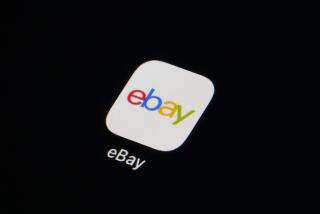Will Users Buy E-Tailer’s Higher Rates?
For much of the past year, Internet superstore Buy.com Inc. has been nudging up its prices ever so carefully in a bid to make money without losing customers.
“It’s like boiling a frog,” said Chief Financial Officer Mitch Hill.
Now, the real test of the Aliso Viejo company’s strategy has arrived. The holiday shopping season will tell how many consumers stay with Buy.com’s newly sober-eyed, more mature business plan and how many bolt.
“With Best Buy and Wal-Mart getting more serious about online sales, it’s never going to get any easier,” said Jim Williamson, a senior analyst at research firm IDC. “If they don’t do well at Christmas, people may give up on them.”
Buy.com’s predicament is hardly unique.
Online retailing has undergone an industrywide shakeout since the spring. One “dot-com” shuts down per day, a recent survey showed, and at least 130 have died this year. Despite an expected infusion of $10 billion from shoppers this holiday season, analysts expect the carnage to continue as marginal companies that went public in last year’s frenzy run out of cash.
Buy.com, although now the second-largest online store, endured a tepid summer in which its sales growth weakened and its gross profit margins improved only slightly. It continues to blow through more than $20 million per quarter and, at that rate, would be broke at the end of next year.
There’s little hope of additional funding from public markets, analysts said: Buy.com’s shares set a new low of $1.25 on Friday, down 90% since the company went public in February.
The company’s long-term hopes ride on its extreme shift in approach. Once the enfant terrible of e-tailing, Buy.com has thrown out its feckless, growth-at-any-cost philosophy in favor of old-fashioned fundamentals this year.
It identified its core consumers as mostly men, age 18 to 49, who are early adopters of the latest gadgetry, and it added product categories such as wireless devices and sporting goods tailored to them. It dumped stuff like travel packages they don’t want or buy elsewhere, Hill said.
Buy.com customers are buyers, not browsers, so the company sank millions into redesigning its Web site for maximum convenience and speed. To conserve cash, the company eschewed an expensive holiday ad campaign and crafted guy-oriented giveaways linked to the Super Bowl and Howard Stern’s radio show.
“We’re one year smarter and a lot more targeted than we were last year,” Hill said. “We view what we’ve been doing as resetting the business.”
But the most important--and potentially perilous--change is this: The company that made its name by promising the “lowest prices on Earth” and giving products away at 10% to 20% below cost has been raising its rates.
Analysts applaud the company’s newfound common sense, but remain skeptical that the Internet’s ultimate hare can succeed by metamorphosing into a tortoise. They point to several signs that the company has fallen behind some of its main rivals:
* In the third quarter, Buy.com’s sales grew 20%, compared with industry leader Amazon.com Inc.’s 80%. Buy.com’s revenue comes mostly from nonseasonal computer products, so it expects 10% to 20% revenue gains for the holiday shopping season, well below the 60% some analysts project for online retailers overall.
“They need to be in that ballpark too,” Williamson said.
* Despite Buy.com’s efforts to narrow its losses by gradually boosting prices, it lags competitors there too. It grosses less than 7 cents for every dollar of sales, while Egghead.com Inc., its chief rival for computer-products customers, pockets more than a dime. Cyberian Outpost Inc., another technology e-tailer, takes home 14 cents.
“If Egghead can raise gross margins faster, why can’t they?” said Daniel Ries, an analyst at C.E. Unterberg, Towbin. “Because Buy.com has always gotten its customers through pure pricing. The companies that are in better positions, like Amazon or Cyberian Outpost, are service leaders.”
Hill acknowledged that Buy.com’s patient, methodical strategy may make for less showy results right now, but said the company is still on a pace to break even by early 2002. He also said it remains a strong enough player to benefit from the shakeout, acquiring partnerships and investors as other dot-coms fail.
“The good news is that a lot of [other] people are going to be gone,” he said. “It’s a really tough market for a lot of companies, and we’re trying to power through.”
(BEGIN TEXT OF INFOBOX / INFOGRAPHIC)
E-Tailers Looking for Good Tidings
The holiday shopping season will prove crucial to many online retailers like Orange County-based Internet superstore Buy.com Inc. as they struggle to survive a brutal market. How Buy.com stacks up with rivals:*--*
Buy.com Amazon.com Egghead.com Cyberian Outpost Founded: 1997 1995 1994 1995 Products: Technology/ Books, music/ Technology/ Technology general general electronics No. of items: 950,000 18 million 70,000 170,000 Revenue:* $596.9 $1,639.8 $514.8 $188.6 Losses:* --130.2 --720.0 --154.9 --35.6 Ticker: BUYX AMZN EGGS COOL Stock price:** $1.25 $27.44 $1.66
*--*
*Results for 1999, in millions.
**Friday’s close.
(BEGIN TEXT OF INFOBOX / INFOGRAPHIC)
Bricks Crowd In on Clicks
Early on, Internet retailers like Amazon.com and Buy.com had the electronic market to themselves. But lately, the bricks-and-mortar stores like Kmart’s BlueLight.com have made inroads. A ranking of the more general-merchandise e-tailers:
*--*
General online retailers Unique visitors (in thousands) Amazon.com 16,307 Barnesandnoble.com 4,957 CDNow.com 3,710 Buy.com 3,541 JCPenney.com 2,743 BlueLight.com 2,696 BestBuy.com 2,663 Sears.com 2,538 EToys.com 2,285 Target.com
*--*
*
Unique visitors: The number of total users who visited the reported Web site or online property at least once in the given month. All unique visitors are unduplicated (counted only once)
Source: Bloomberg News, Media Metrix
More to Read
Inside the business of entertainment
The Wide Shot brings you news, analysis and insights on everything from streaming wars to production — and what it all means for the future.
You may occasionally receive promotional content from the Los Angeles Times.










